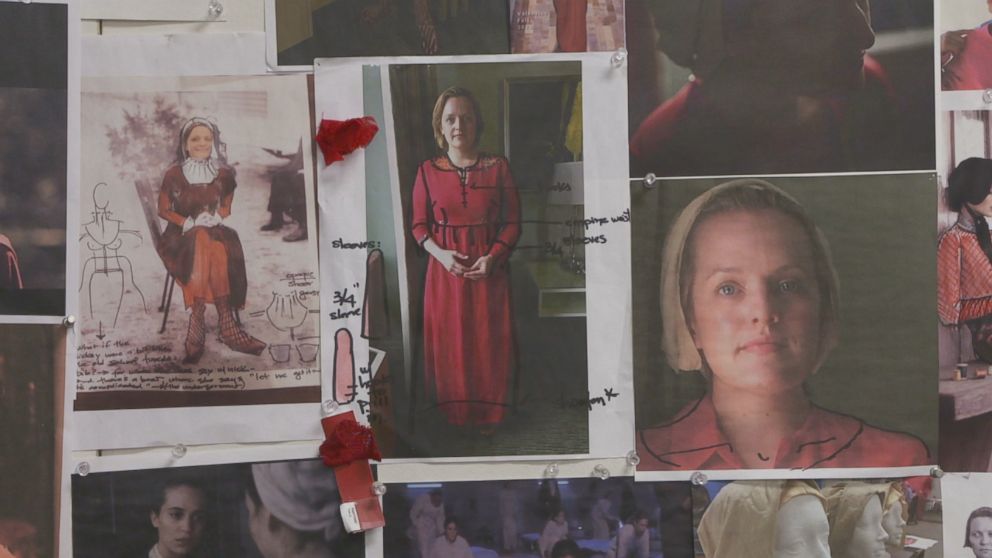The hidden meanings behind the designs, colors of the 'The Handmaid's Tale' costumes
Breaking down the show's iconic looks with designer Ane Crabtree.
The iconic look of Hulu’s breakout hit “The Handmaid’s Tale” is, in large part, due to award-winning costume designer Ane Crabtree.
The wardrobe she created for the show is so recognizable that it’s become a popular choice for Halloween costume and protest marches.
“We make, not a hundred percent, but at least ninety percent of it here,” she told "Nightline." “Our present day is actually you know three years in the future at best, although it’s so closely married to modern, what’s happening in modern politics. It really is only a hint of the future and so all of America, all of the clothing has been taken away. In my mind, we try to make a good, realistic intellectual sense of who made all these clothes.”

Most of the costumes are designed to look uniform, except for the clothes worn by Joseph Fiennes, who plays Commander Waterford, and Yvonne Strahovski, who plays his wife, Serena, “because they’re the 1 percent,” she said.
The walls of Crabtree’s studio are lined with unlikely inspirations and influences. Cary Grant, for Fiennes’ sharp suits and long flowing topcoats. Coco Chanel, for Strahovski. Debbie Harry and Patti Smith for June, the main character played by Elisabeth Moss who ultimately becomes the handmaid at the center of the story.
Crabtree took home the 2018 Costume Designers Guild Award.
The palette she works with is mostly primary colors, as prescribed in Margaret Atwood’s book. As with Star Trek uniforms, the colors denote a person’s role in society. Robin’s-egg blue for the wives, charcoal and black for the husbands, dark brown for the aunties, and of course dark red for the handmaids.

“It’s like blood,” she said. “Everything is by design. We went through a million different shades of red, and we knew that it had to match any skin tone and be beautiful -- from a beautiful porcelain white Lizzie Moss, to a beautiful chocolate Samira Wiley.
"Also, red is so impossible usually on film. It can be really ugly," she continued. "It can take all the color and pull it towards itself and you’re not going to look at anything else. Of course you still do that a little bit in our show, but I tried to find what I call an intellectual red. That wasn’t blaring.”
As for the other iconic looks of her designs, “I call them tribal uniforms because each tribe does exactly what they are deemed to do,” she said. “So they are in that way like Star Trek. But I always say that the simplicity makes the real estate really difficult and really important. More pertinent than any other show because you can’t over design this.”
Crabtree also designed the iconic bonnets the handmaids wear, their “wings,” which fit snugly on the head, held in place with magnets against the wind gusts in Toronto, where the show is filmed.
“It’s used as a lightbox because there’s, well not zero, but very little makeup. It’s natural,” she said. “And it’s a way to actually create light in the face.”
The bonnets, she says, also serve as a secondary function because makeup would look out of place in the handmaid’s world.
“The hidden stuff is we have to redesign for the weather in Canada because it’s freezing, right?” she told Nightline. “I didn’t want a show where everyone is walking around in sleeping bags, it wouldn’t be good for the story. I’m learning on this show a way to make things hidden, they're kind of like inventions on warmth.”
Referencing the handmaids’ standard uniform, Crabtree shared, “This is a kind of very modern, sporty, Gortex that we now secretly use to put the inside the capes.”
Crabtree mostly works with her team of designers, but when schedules permit, she and the show’s Emmy winning Director of Photography Colin Watkinson merge their talents.
“It’s like two kids making a plan for something crazy, seriously we get that excited, even after thousands of months.”
As the show’s cinematographer, Watkinson, agrees: “It’s good to understand the color palette. [The show] has a very strong color palette, and, every time I speak to Ane, I feel very confident to what we’re doing. I love coming down here and talking about it.” Their collaboration has created a winning formula. “He tells me how he’s going to shoot it, how he’s going to paint it with light, and our brains start to meld together… It’s really good, he’s my partner in crime.”




